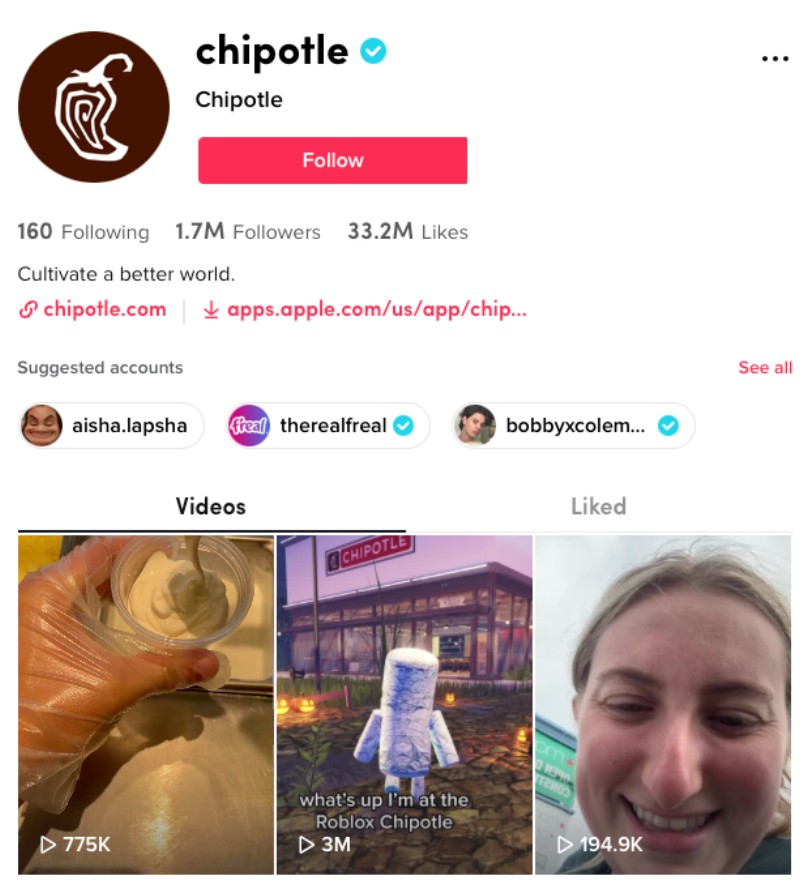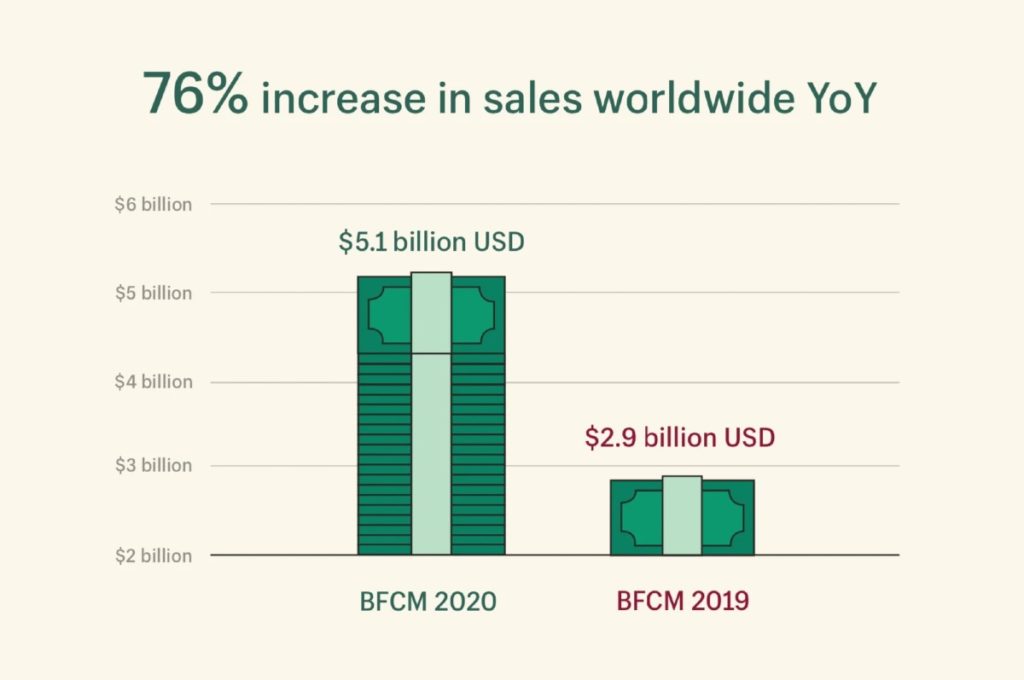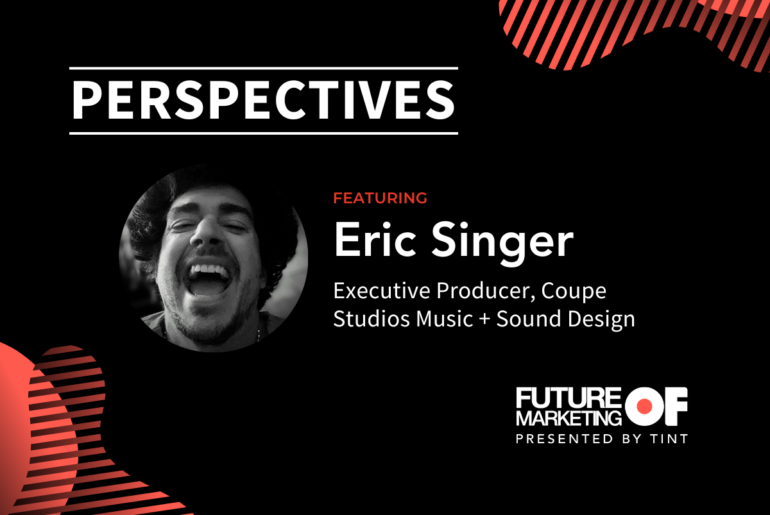The future of retail marketing is in the “phygital” shopping experience.
As McKinsey leader Eric Hazan explains, “We are entering the world of “phygital”—physical and digital at the same time, where there is not a physical world or digital world in retail, but rather a completely connected one.”
And we couldn’t agree more. The phygital shopping experience is already here. If a store doesn’t have its size in stock, customers can easily pull up their website and order the correct size to their front door. Retail is officially omnichannel.
COVID-19 rushed the world online, creating a 76% increase in sales worldwide between Black Friday/Cyber Monday of 2020 and 2021. As Shopify reported at the end of 2020:
- The number of consumers purchasing from Shopify merchants has grown by 50% since last year
- Shoppers check out with a 25% higher cart size when they opt for local pickup and delivery
- Email, direct, search, and social were the top 4 conversion rate referrers
The future of retail is omnichannel, which means marketing needs to follow suit.
The Future of Retail Marketing
Retail marketing is officially omnichannel, using channels like in-store shopping, local pickup, delivery, email, social media, paid ads, and SEO to acquire customers. The future of retail marketing will require as many channels as possible to capture an audience and convert them into customers.
Personalization Across Channels
Marketers have known for over a year the importance of meeting customers where they are (on their platform of choice). But now, marketing needs to take things a step further. Omnichannel commerce isn’t just cross-channel marketing. It’s also a personalization strategy.
Every channel that can meet the customer specifically where *they* are in the customer journey…should. This applies to apps, emails, paid ads, DMs, and more.
- Apps can achieve this by changing promotions based on a user’s interests.
- Email marketing can do this through segmentation.
- Paid ads can target people who have left specific products in their cart
- Chatbot DMs can send an audience member further information based on their inquiry and tag them for specific funnels
Start Using Pricing Automation
No, it doesn’t just so happen that your favorite restaurant to order off of on Uber Eats always has great deals. The platform knows you love to order from there (*and* knows what you like to get). They can personalize pricing and promotions based on your interests and prior purchases.
Ecommerce companies can start to personalize their pricing across their emails, apps, and paid ads.
- Emails: Increase promotions, discounts, freebies, or exclusive for hot leads
- Apps: Promote products based on interests and prior purchases
- Paid ads: Show promotional discounts to hot leads (ex. people with abandoned carts)
Nurture Relationships through Brick-and-Mortar Experiences
Brick-and-mortar isn’t the only place for customers to buy, which changes its role in the customer journey. It’s no longer the end of the journey but the beginning and middle as well. Retail space can be used to nurture relationships with customers through shopping experiences, events, and pop-ups.
Use brick-and-mortar stores to:
- Turn cold and warm leads into hot leads either by buying in-store or purchasing online later
- Give customers the chance to interact with products in person (feeling material, trying on for size, etc.)
- Showcase high-quality customer service that builds the know, like, and trust marketing factor
With the future of commerce focused on the omnichannel experience, retail marketers can use new trends and technology to nurture, build, and establish long-term relationships with their customers (hello LTV!).
How To Market Retail in 2022
Retail marketing doesn’t have to be scared of iOS updates and privacy regulations. It can still thrive with more limitations and, pro, more consumer privacy. Brands will just have to focus on customer sentiment, voice technology, and personalization to create the experiences people are looking for.
Use Your Customer’s Voices
Customers are talking, but brands don’t always listen. User-generated content is circulating social media faster than most brands can keep up with. Disappearing Instagram stories and posts that don’t tag the brand make finding UGC challenging for marketers – which is why brands should ask fans to tag them. In fact, more than half of consumers wish brands would tell them what type of content to create and share.
UGC decreases content production budgets while filling your marketing channels with the highest converting content we’re seeing online today – and customers want to make it.
- Ads based on user-generated content receive 4 times higher click-through rates and a 50% drop in cost-per-click than average ads.
- One-quarter of search results for the world’s biggest brands are links to user-generated content.
- There has been an increase of 29% in web conversions when websites featured user-generated content.
Chipotle exclusively leveraged their customer voice to get 1.7 million TikTok followers (and 33.2 million likes):

Hop on To Voice Technology
Voice is the new wave of retail marketing, and businesses, like McDonald’s, have already caught on. In June 2020, McDonald’s placed 10 voice-ordering kiosks in their Madrid location. As Rain Agency points out:
- Carrefour worked with Google Assistant to create voice-based online shopping so customers could add products to their shopping carts without leaving home.
- Amazon is placing Echos in its Fresh grocery store so shoppers can ask where to find products.
- Walmart employees are Asking Sam for price lookups, product locations, and emergency alerts.
Voice technology has lots of uses, both in the customer journey and behind the scenes. The future of retail marketing will rely on voice to help customers and check out—creating a new need for voice technology in retail stores.
Personalize Online Shopping
Even with privacy changes around every corner, personalizing the online shopping experience is still possible. It’ll just require more first-party data than needed before. Personalized shopping uses algorithms (like Facebook’s ad platform) that understand user preferences and behavior to create differing experiences for customers.
For example, a customer showing the most interest in buying Nike sneakers can get redirected to a homepage with promotion and above-the-fold graphic of sneakers. Another customer interested in athletic outerwear will see a totally different homepage promotion and above-the-fold graphic tuned to their desired outerwear purchase.
Personalized shopping can use algorithms and even email segmentation. Surveying customers can create segmentation opportunities to personalize the shopping experience.
- What products do they like the most?
- Which products are on their holiday gift list?
- Where do they live?
The Phygital Shopping Experience
The future of retail marketing is a phygital shopping experience. It’s the mix between the online and in-person channels that create a truly holistic marketing approach. The customer journey is no longer a straight line from an organic social media post to conversion. It’s now:
- Social media posts
- Paid ads
- SEO
- Website visits
- Retail stores
- Pop-ups
- Exclusive events
- The metaverse??
As long as marketers keep up with changes, they’ll be able to continue to adapt. And the best way to do that is always to know what the future of marketing is. Join the 25,000 marketers reading the future of marketing weekly to learn what’s on the horizon—and what that means for your ROAS.






